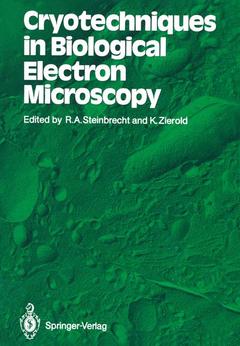Cryotechniques in Biological Electron Microscopy, Softcover reprint of the original 1st ed. 1987
Langue : Français
Coordonnateurs : Steinbrecht Rudolf A., Zierold Karl

To preserve tissue by freezing is an ancient concept going back pre sumably to the practice of ice-age hunters. At first glance, it seems as simple as it is attractive: the dynamics of life are frozen in, nothing is added and nothing withdrawn except thermal energy. Thus, the result should be more life-like than after poisoning, tan ning and drying a living cell as we may rudely call the conventional preparation of specimens for electron microscopy. Countless mishaps, however, have taught electron microscopists that cryotechniques too are neither simple nor necessarily more life-like in their outcome. Not too long ago, experts in cryotechniques strictly denied that a cell could truly be vitrified, i.e. that all the solutes and macro molecules could be fixed within non-crystalline, glass-like solid water without the dramatic shifts and segregation effects caused by crystallization. We now know that vitrification is indeed pos sible. Growing insight into the fundamentals of the physics of water and ice, as well as increasing experience of how to cool cells rapidly enough have enlivened the interest in cryofixation and pro duced a wealth of successful applications.
I Fundamentals.- 1 Physics of Water and Ice: Implications for Cryofixation.- 1 Introduction.- 2 Functions of Water in Cryospecimens.- 3 Water Below Room Temperature.- 4 Aqueous Solutions Below Room Temperature.- 5 Specimen Cooling.- References.- 2 The Response of Biological Macromolecules and Supramolecular Structures to the Physics of Specimen Cryopreparation.- 1 Introduction.- 2 The Hydration Shells of Biological Macromolecules and Supramolecular Structures.- 3 Phases and Interface Phenomena.- 4 The Particular Case of the Biological Membrane.- 5 A Potpourri of Collapses.- References.- 3 Electron Beam Radiation Damage to Organic and Biological Cryospecimens.- 1 Introduction.- 2 Electron Beam/Specimen Interaction.- 3 Radiation Damage to Organic Materials at Low Temperature.- 4 Radiation Damage to Ice.- 5 Radiation Damage to Frozen-Hydrated and Vitrified-Hydrated Specimens.- 6 Conclusions.- References.- II General Methodology.- 4 Cryofixation Without Pretreatment at Ambient Pressure.- 1 Introduction.- 2 Cryofixation with Liquid Cryogen.- 3 Impact Cryofixation (Slamming).- 4 Discussion.- References.- 5 Cryoeleetron Microscopy of Vitrified Specimens.- 1 Introduction.- 2 Vitrification.- 3 Preparation of Thin Specimens.- 4 Image Formation.- 5 Beam Damage.- References.- 6 Cryoultramicrotomy.- 1 Introduction.- 2 Technical Aspects of Cryoultramicrotomy.- 3 Physical Aspects of Cryoultramicrotomy.- 4 Conclusions.- References.- 7 Freeze-Substitution and Freeze-Drying.- 1 Introduction.- 2 Methodology: Theoretical and Experimental Data.- 3 Procedures and Instrumentation.- 4 Critical Evaluation.- References.- III Special Aspects.- 8 Theory and Practice of High Pressure Freezing.- 1 Introduction.- 2 Freezing Under Atmospheric Pressure.- 3 Freezing Under High Pressure.- 4 The Main Practical Problems of Pressure-Freezing.- 5 The High Pressure Freezing Machine (Balzers HPM 010).- 6 Some Practical Advice.- 7 Discussion of Results.- References.- 9 Freeze-Etching of Dispersions, Emulsions and Macromolecular Solutions of Biological Interest 192.- 1 Introduction.- 2 Specific Problems of Specimen Preparation.- 3 Determination of Particle Concentrations and Molecular Weights.- 4 Measurements of Size and Shape.- 5 Structure of Dispersions in Bulk and at Interfaces.- References.- 10 High Resolution Metal Replication of Freeze-Dried Specimens.- 1 Introduction.- 2 Electron Microscopy and Image Processing.- 3 Characterization of the Test Specimens.- 4 Controlled Freeze-Drying.- 5 High Resolution Shadowing.- References.- 11 Immunogold Labelling of Cryosections and Cryofractures.- 1 Introduction.- 2 Cryoultramicrotomy.- 3 Cryofractures.- 4 Label Efficiency.- 5 Conclusions.- References.- 12 Cryoultramicrotomy for Autoradiography and Enzyme Cytochemistry.- 1 Introduction.- 2 Cryoultramicrotomy for the Autoradiography of Diffusible Substances.- 3 Thin Cryosections in Histochemistry.- 4 Conclusions.- References.- 13 Scanning Electron Microscopy and X-Ray Microanalysis of Frozen-Hydrated Bulk Samples.- 1 Introduction.- 2 Morphology.- 3 Analysis.- 4 Freezing.- 5 Instrumentation.- 6 Electron Interactions.- 7 X-Ray Emission.- 8 The Fracture Surface.- 9 Quantitative Analysis.- 10 Water Content or Dry Weight Fraction.- 11 Beam Damage and Mass Loss.- 12 Detection Limits.- 13 Conclusions.- References.- 14 Cryofixation of Dynamic Processes in Cells and Organelles.- 1 Introduction.- 2 Cooling Rate, Freezing Time, Time Resolution.- 3 Cellular Structures: Rapid Freezing Versus Chemical Fixation.- 4 Membrane Dynamics.- 5 Conclusions and Outlook.- References.- 15 Cryofixation of Diffusible Elements in Cells and Tissues for Electron Probe Microanalysis.- 1 Introduction.- 2 Specimen Preparation.- 3 Some Biological Applications and Results.- 4 Conclusion and Outlook.- References.- IV Appendix.- 16 Safety Rules for Cryopreparation.- 1 Introduction.- 2 Asphyxiation with Gaseous Nitrogen.- 3 Gaseous Propane Explosions.- 4 Burns Caused by Secondary Cryogen Splashing.- 5 Burns Caused by Primary Cryogen Splashing.- 6 Ignition of Combustible Secondary Cryogens.- 7 Bursting of Cryogen Containers.- 8 Transport and Disposal of Cryogens.- 9 Concluding Remarks.- References.
Date de parution : 12-2011
Ouvrage de 297 p.
17x24.4 cm
Disponible chez l'éditeur (délai d'approvisionnement : 15 jours).
Prix indicatif 105,49 €
Ajouter au panierThèmes de Cryotechniques in Biological Electron Microscopy :
Mots-clés :
X-ray; electron microscopy; enzyme; enzymes; high pressure; microscopy; molecule; replication; tissue
© 2024 LAVOISIER S.A.S.
